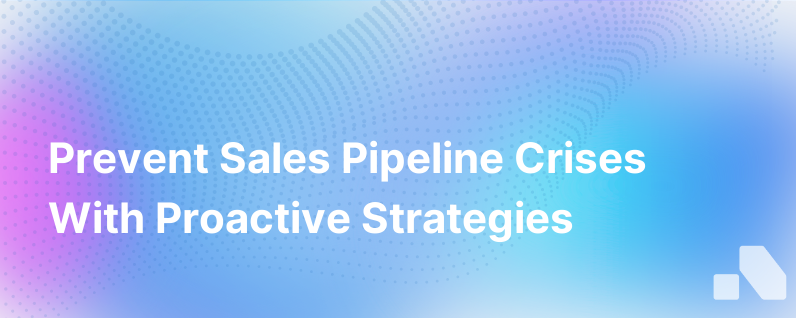
A pipeline crisis is a daunting challenge for any sales team. It's a period when the influx of new prospects dries up, existing leads stagnate, and deals start to fall apart, potentially leading to a revenue shortfall that can put the entire business at risk. But the truth is, a pipeline crisis seldom comes out of the blue. There are usually early warning signs, and by recognizing these and taking proactive steps, such a crisis can often be averted.
In this article, we explore what a healthy sales pipeline should look like, how to spot potential red flags, and strategies to prevent a pipeline crisis from taking hold. Getting ahead of a potential crisis is all about vigilance, quick response, and strategic planning.
A Healthy Sales Pipeline: The First Line of Defense
Before delving into prevention, it's vital to understand what a healthy sales pipeline looks like and why it's important.
A healthy pipeline is typically characterized by:
- A steady flow of high-quality leads at the top.
- A balanced distribution of leads at different stages of your sales process.
- A consistent conversion rate from one stage of the process to the next.
- An appropriate velocity at which leads move through the pipeline.
This healthy state is the first line of defense against a crisis as it offers the buffer needed to address issues without significant distress. Regularly measuring and understanding these metrics offers clarity on pipeline health and early detection of potential problems.
Spotting the Red Flags: Early Detection Methods
Awareness is key in preventing a pipeline crisis. Sales teams should constantly monitor several indicators for early warning signs. Here are a few:
- A dramatic drop in new leads: This could indicate issues with lead generation strategies, marketing campaigns, or external market factors.
- Decreased lead quality: A sudden influx of leads that don't meet your ideal customer profile could waste the time of your sales team and bloat your pipeline with unwinnable opportunities.
- Stalled deals: If a significant number of deals are not progressing as expected, it might indicate an issue with sales tactics or changes in buyer behavior.
- Lengthening sales cycles: An elongated sales cycle might mean increased competition or internal inefficiencies.
- Lower conversion rates: A decrease in conversion rates at any stage could signal problems with your value proposition, sales skills, or market positioning.
Regular reviews of these metrics should be part of your business rhythm, so you can catch issues before they escalate.
Strategies for Preventing Pipeline Crises
Now let’s look at some strategies that can help keep your sales pipeline flowing:
1. Maintain a robust lead generation strategy
Diversify your lead generation activities to mitigate risk. Relying on a single channel or tactic for lead generation is dangerous. Experiment with content marketing, email campaigns, social selling, networking, and partnership opportunities.
2. Qualify leads rigorously
Not every lead is worth pursuing. Implement a qualification framework like BANT (Budget, Authority, Need, Timing) to ensure you’re filling your pipeline with potential buyers who are a good fit for your product or service.
3. Keep a close eye on metrics
Consistent sales forecasting and monitoring are crucial. Use a CRM to track key performance indicators (KPIs) and set up dashboards for real-time insights. If numbers start to trend negatively, investigate and address the underlying issues immediately.
4. Align Sales and Marketing
Make sure your marketing team's lead generation goals and content strategy are aligned with the sales pipeline needs. Regular meetings between sales and marketing leaders can ensure a mutual understanding of goals and strategies.
5. Invest in sales enablement
Equip your sales team with the necessary tools and information. Sales enablement includes proper training, providing relevant content, and sharing best practices to enhance sales performance.
6. Encourage repeat business and referrals
Existing customers can be the key to pipeline sustainability. Encourage upsells, cross-sells, and seek referrals. Satisfied customers can become your advocates, leading to new opportunities.
7. Stay adaptable to market changes
Be aware of industry trends and keep flexibility in your sales approach. The ability to pivot strategies quickly is crucial when facing sudden market changes.
8. Leverage technology
Invest in technologies like CRM and sales intelligence tools to streamline processes and provide actionable insights. An AI-based platform like Aomni can automate the account research process and deliver real-time insights, which can help in averting a crisis.
9. Cultivate a robust sales culture
A strong sales culture encourages accountability, continuous learning, and proactive behavior. Regular coaching and recognition for performance can invigorate your team.
10. Continuous pipeline reviews
Establish a rhythm for regular pipeline reviews. Identify bottlenecks, coach on specific deals, and realign strategies to ensure progress. Joint problem-solving during these reviews can prevent small issues from turning into a crisis.
The Role of Sales Intelligence in Preventing Pipeline Crises
Sales intelligence tools, like the ones provided by Aomni, can play a critical role in preventing pipeline crises. By automating the data collection and analysis process, sales teams can:
- Gain real-time insights into account health.
- Analyze customer sentiment.
- Receive alerts on key account activities.
- Generate actionable competitive insights.
- Personalize sales outreach with minimal effort.
By leveraging these tools, sales teams can stay on top of their pipeline health, making it possible to take corrective action swiftly.
Conclusion
While no organization is immune to pipeline fluctuations, being vigilant and proactive can keep potential crises at bay. Regularly examining your pipeline health, leveraging a robust sales intelligence tool like Aomni, and staying adaptable in the face of market changes are the keys to preventing a pipeline crisis before it begins. By embedding these practices into your sales process, you’ll not just prevent crises; you'll also position your organization for sustainable growth.